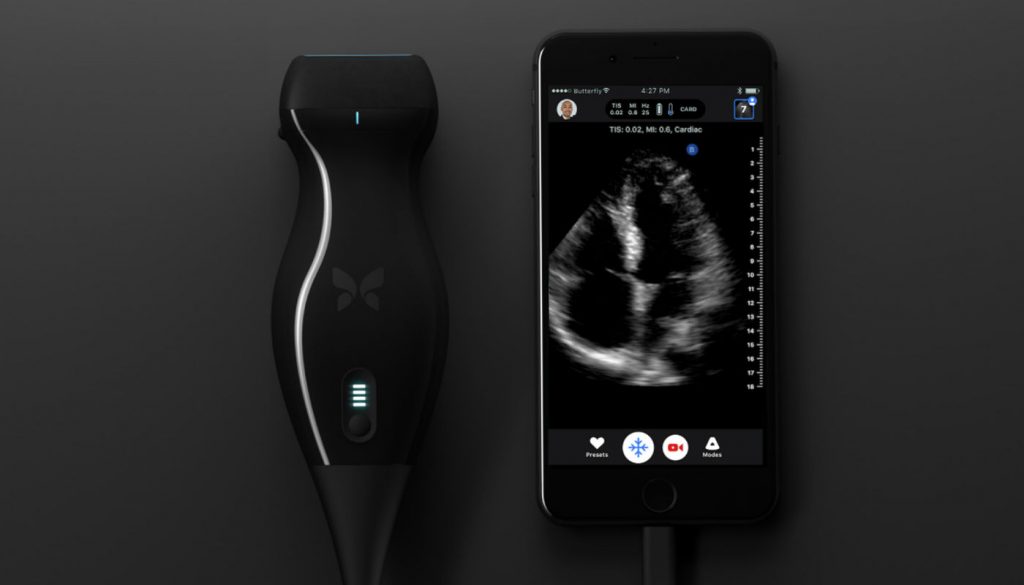One engineer is borrowing techniques from the microelectronics industry to put ultrasound machines in every household.
US engineer and entrepreneur Jonathan Rothberg is determined to “democratise” ultrasound technology with an economical, artificial intelligence (AI) enhanced probe that plugs directly into a smartphone.
Rothberg told IEEE Spectrum that he hopes the Butterfly iQ ultrasound system will start a revolution in medical imaging access that will eventually see ultrasound units as common in household medical kits as the thermometer is today. The device will be released this year by Rothberg’s startup, Butterfly Network.
According to Butterfly Network’s Chief Medical Advisor John Martin, this will lead to benefits such as parents being able to check children for broken bones after falls, rather than facing a long wait in a hospital emergency room.
While the device is not yet approved for domestic use, Martin cited past examples of medical equipment that had moved out of hospitals into the public arena.
“When the first thermometers were made, when the first blood pressure cuffs were made, they were only in hospitals. Think about defibrillators, which used to only be in hospitals but are now in every mall and office – someone off the street can now deliver an electric shock to someone’s heart,” he said.
Balancing portability and price
In Australia, ultrasound was pioneered by David Robinson and George Kossoff, who built the CAL Echoscope in 1961 as a safer alternative to x-raying pregnant women to determine the health of their unborn babies.
While access to ultrasound for prenatal and diagnostic imaging is good in urban and large regional centres of the country, there are still issues with providing adequate services in rural and remote communities. Some initiatives have tried to alleviate this problem by providing training to midwives and doctors to provide primary care with portable ultrasound units, and robotic ultrasounds are also an emerging solution.
Portable units, such as the General Electric VScan, are smaller and cheaper than their high-end hospital-based counterparts, which can cost more than USD$100,000. But they still have a price tag between USD$8,000 and USD$20,000 and require training for correct operation.
The Butterfly iQ is set to significantly undercut the cost of existing conventional and portable ultrasound units, making use of mass-production techniques established for the manufacture of computer chips.
“We put all the elements onto a semiconductor wafer, then we can dice up the wafer to make 48 ultra low-cost ultrasound machines,” Rothberg said.
The release price for the device is expected to be around USD$2000, and Rothberg has expressed intentions to lower it in the future.
Below the surface
The device uses different technology from conventional ultrasound equipment, which uses expensive piezoelectric crystals or ceramics to generate sound waves. Instead, the Butterfly iQ uses tiny vibrating drums, known as capacitive micromachined ultrasound transducers (CMUT).
Each Butterfly iQ probe incorporates 10,000 of these transducers. According to Rothberg, they can be “tuned on the fly” to eliminate the need for specialised probes needed to create images at different depths within the body.
“We can make them buzz at 1 megahertz if we want to go deep, or 5 megahertz if we want to go shallow,” he explained.
The transducers are directly connected to amplifiers and signal processors in the semiconductor wafer.
Machine learning algorithms in the probe make it possible for users to find specific parts of the body without specialised operator training. Butterfly Network is also is seeking approval to equip the AI within the probe with deep learning software, that will be trained to recognise the difference between a high- and low-quality image of various internal organs and anatomical features.
The device has gained approval from the US Food and Drug Administration (FDA) for 13 procedures including prenatal examinations, heart checkups and musculoskeletal scans.
And Rothberg has big plans for the future.
“In the next two years we’ll release a patch that uses ultrasound to monitor patients, and a pill you can swallow to look at cancer from within the body,” he said.
